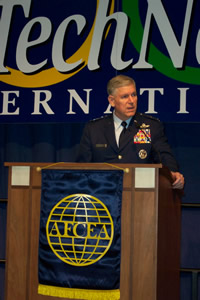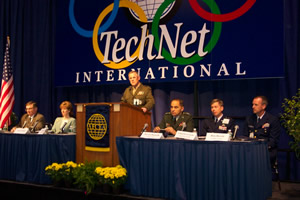Tuesday, May 11, 2004
TechNet International 2004 Day 1
Quote of the Day:
“We have our own asymmetric advantage … our own C3.”
—Gen. Richard B. Myers, USAF, chairman of the Joint Chiefs of Staff.
 |
| Gen. Richard B. Myers, USAF, chairman of the Joint Chiefs of Staff, addresses the Tuesday luncheon audience at TechNet International 2004. |
TechNet International 2004, AFCEA International’s annual conference and exposition in Washington D.C., began with a two blockbuster events to inaugurate three days of conferences, speakers, panels and courses. Being held May 11-13 at the Washington Convention Center, this year’s event was titled “Combating Emerging Threats.”
The star of the first day’s events was Gen. Richard B. Myers, USAF, chairman of the Joint Chiefs of Staff. Gen. Myers told a packed luncheon audience that command and control (C2) is the link that holds U.S. forces together, and he also described C2 as “a caulk to fill gaps.”
However, for all our strengths, we still have “plenty of problems,” he warned. Gen. Myers called for solutions to combat identification challenges as well as intelligence gathering and sharing. The services also need a common operating picture as they move from an era of joint warfighting to one of integrated warfighting.
The general emphasized using the term “battlespace awareness” instead of intelligence, surveillance and reconnaissance (ISR). In thinking about the entire battlespace in a holistic way, the military must revisit the concept of having strategic, tactical and national assets. U.S. forces will have “a lot more assets out there” if they are viewed as part of battlefield awareness instead of ISR, he added.
All systems will be nodes in that battlespace awareness, he continued. For example, the Air Force’s new F-22 fighter aircraft generates a “great volume” of radar data as it sweeps the skies. That aircraft must share this great volume of data with the rest of the force to contribute to battlespace awareness. “The C2 that we bring to the team allows us to do incredible things to make the world a safer place,” Gen. Myers declared.
The day’s only panel featured a lively discussion of joint and service command, control, communications and computer (C4) systems. The Plenary Session was moderated by Lt. Gen. Robert M. Shea, USMC, J-6, the Joint Staff, and it featured representatives of all five service J-6 or chief information officer (CIO) offices.
Gen. Shea began by observing that the threat facing the United States may come from terrorists or unknown sources. Accordingly, the country must move to cultural, intellectual and technological changes away from the traditional threat model and toward a capability-based approach.
He emphasized five points: networks link the world, but this also helps our adversaries; collaboration and shared information is a key force multiplier; the network is the center of gravity and will be attacked; new concepts must be encouraged through simulation, training and wargaming; and the military must empower its people with education for all members, not just the C4 community.
 |
| Panelists in the J-6 Plenary Session are (l to r) Mark Mohler of the U.S. Navy; Debra Filippi of the U.S. Marine Corps; panel moderator Lt. Gen. Robert M. Shea, USMC, J-6, the Joint Staff; Lt. Gen. Steven W. Boutelle, USA; Maj. Gen. Charles E. Croom Jr., USAF; and Capt. Ron Hewitt, USCG. |
Lt. Gen. Steven W. Boutelle, USA, Army CIO/G-6, offered that the Global Information Grid Bandwidth Enhanced (GIG-BE) is vital to Army C4 efforts. Step sites, teleports and Global Broadcast System sites are the key to the architecture, and this effort will increase the capacity of the fixed infrastructure. Despite success in Iraq, that operation revealed some shortcomings. The general called for large bandwidth down to the battalion level.
Maj. Gen. Charles E. Croom Jr., USAF, director of Air Force C4ISR and deputy chief of staff for warfighting integration, discussed “a network in the sky” featuring shared data, Internet protocol (IP)-based routing and assured service. Every platform becomes a sensor or a router moving information across the network. This will provide instantaneous, time-sensitive targeting through a single network linking ground, air and space. The general cited the need for satellites to provide beyond-line-of-sight links.
Mark Mohler, acting deputy director for C4 integration and policy and deputy CIO for the Navy, discussed how the Navy’s FORCEnet program is changing the service. One challenging aspect is that the Navy must maintain its legacy networks while transitioning, he noted.
Debra Filippi, deputy director C4/deputy CIO, Marine Corps, explained how sea-basing will provide force advantages through information technologies. The Iraq War highlighted some shortcomings, such as considerable limitations on over-the-horizon C4 capabilities and providing data to lower echelons. C2 on-the-move also needs improving.
Capt. Ron Hewitt, USCG, deputy, assistant commandant for C4 and information technology, Coast Guard, described how the Deepwater project will incorporate fundamental changes in Coast Guard equipment and functions. Observing that the Coast Guard must communicate and exchange information with the homeland security community, the military and the search and rescue community, the captain explained that satellite communications will play a bigger role in the Coast Guard’s future. This includes commercial systems such as Inmarsat and Iridium, he added.
—Scheduled for Wednesday at TechNet International 2004: An address by Gen. Tommy Franks, USA (Ret.), commander of the U.S. Central Command during the Afghanistan and Iraq wars; and a panel discussion on protecting America’s critical infrastructures.




Comments